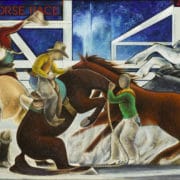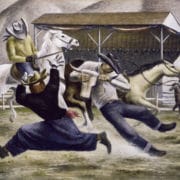Art of the New Deal
Explore the works discussed in the video below. Click the thumbnails to expand.
The Great Depression, which forced millions of Americans out of work, was no less devastating to artists, and their needs were addressed in the economic relief programs of the Roosevelt administration. The Federal Art Projects benefited musicians and theatre personnel as well as artists, and they also made the fine arts available to a vast audience. The government commissioned paintings for post offices, state capitols, and federal buildings in Washington, D. C. In style and subject matter, these works belong to the American Scene movement. However, the younger artists involved in these public art projects, such as the Coloradan Frank Mechau, were not immune to the influence of modernist abstraction. The career of California painter Maynard Dixon was well under way when the Depression began, but he too turned to government commissions for support in the 1930s. Like Mechau, Dixon preferred western themes and developed a style of flattened and simplified forms well-suited to the scale of mural painting.
| ← Abstract Expressionism | Expeditionary Artists → |
| Return to the Anschutz Collection | |




